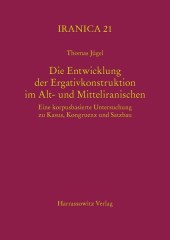 Farridnejad, Shervin, Anke Joisten-Pruschke & Rika Gyselen (eds.). 2015. Faszination Iran. Beiträge zur Religion, Geschichte und Kunst des Alten Iran. Gedenkschrift für Klaus Schippmann. (Göttinger Orientforschungen. III. Reihe: Iranica, Neue Folge 13). Wiesbaden: Otto Harrassowitz Verlag.
Farridnejad, Shervin, Anke Joisten-Pruschke & Rika Gyselen (eds.). 2015. Faszination Iran. Beiträge zur Religion, Geschichte und Kunst des Alten Iran. Gedenkschrift für Klaus Schippmann. (Göttinger Orientforschungen. III. Reihe: Iranica, Neue Folge 13). Wiesbaden: Otto Harrassowitz Verlag.
The volume consists of eleven papers, written by some of the foremost scholars in the field of Iranian Studies as well as some of his lifetime friends and colleagues. The articles are essentially concerned with different aspects of Ancient Iranian Art, Archaeology, History, Numismatics and Religion, reflecting the scholarly interests of Klaus Schippmann. The volume is accompanied also by parts of his unpublished private diary (1959) from his Nachlass, reflecting his ideas, visions and memories of his excavations as well as one report of his last trip to his favourable archaeological site of taḫt-e soleymān (Iran), written by his personal tour leader. The book is illustrated by numerous plates.
This volume could be of interest for scholars and students of Ancient Iranian Art, Archaeology, History, Religion and other neighbour disciplines.
- In Memoriam Klaus Schippmann
- Anke Joisten-Pruschke: „Ich muss irgendwie sehen, dass es für mich einen Weg gibt Archäologie zu studieren“ – Klaus Schippmanns Tagebuch einer Reise in den Vorderen Orient (1959)
- Oric Basirov: “Proselytisation” and “Exposure of the Dead”:
Two Christian Calumnies Commonly raised against the Sasanians - Vesta Sarkhosh Curtis: “Observations on some coins of Persis”
- Touraj Daryaee: “The Xwarrah and the Sēnmurv: Zoroastrian Iconography on Seventh Century Copper Coinage“
- Shervin Farridnejad: “Das zoroastrische mār-nāme „Schlangenbuch“. Zur zoroastrischen Volksreligion und Ophiomantik”
- Rika Gyselen: “Some Thoughts on Sasanian mgwh-Seals”
- Bruno Jacobs: “Zur bildlichen Repräsentation iranischer Eliten
im achämenidenzeitlichen Kleinasien” - Anke Joisten-Pruschke: “Feudalismus im Sasanidenreich?”
- Wolfram Kleiss: “Hochterrassen – Zikkurati – Stufenpyramiden”
- Karin Mosig-Walburg: “Herrscherpropaganda der Nachfolger Shapurs I. (Ohrmazd I. – Narse) – Ein Beitrag zum Verhältnis von König und Adel im Sasanidenreich in der zweiten Hälfte des 3. Jh. n. Chr.”
- Michael Shenkar: “Aspects of Iconography of Ahura Mazdā: Origins and Significance”
- Dieter Weber: “Spätsasanidische Preislisten im frühislamischen Iran”
- Hartmut Niemann: “Der Kreis schließt sich – Klaus Schippmanns letzte Reise zum ‘Takht’ “
 Kleiss, Wolfram. 2015.
Kleiss, Wolfram. 2015.  Goldman, Leon. 2015.
Goldman, Leon. 2015.  Seyed-Gohrab, Ali-Asghar (ed.). 2015.
Seyed-Gohrab, Ali-Asghar (ed.). 2015. Fitzpatrick-McKinley, A. (ed.). (2015).
Fitzpatrick-McKinley, A. (ed.). (2015). Sharafi, Mitra. 2014.
Sharafi, Mitra. 2014.  Lubotsky, A. (2015).
Lubotsky, A. (2015).  Jügel, Thomas. 2015.
Jügel, Thomas. 2015. 